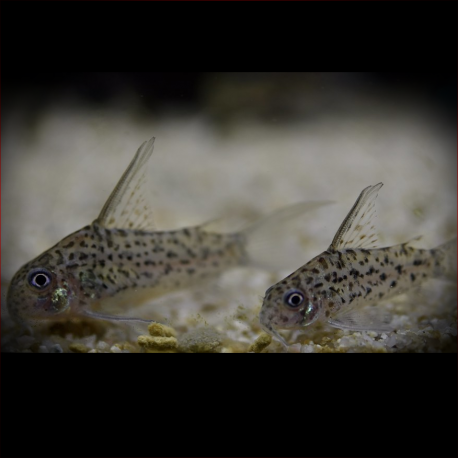More info
Datasheet
| Minimum Tank Size | 50 litres / 13.21 US gallons |
| Maximum Size | 5.0cm / 1.97inches |
| Temperature | 22°C / 71.60°F - 25°C / 77.00°F |
| Hardness | 2-12ºdH |
| pH | 6.0-7.2 |
General Description
Corydoras loretoensis, a member of the Callichthyidae family and Corydoradinae subfamily, is among the over 180 known species of Corydoras catfish. Possessing a striking appearance with an elongated dorsal spine, they are sought after by aquarists due to their peaceful nature and charming aesthetic appeal. Their ability to breathe atmospheric air enables them to survive in low-oxygen conditions, making them adaptive aquarium inhabitants.
Aquarium Setup
To ensure the well-being of Corydoras loretoensis, a tank of at least 50 liters with fine sand substrate, smooth rocks, bogwood chunks, and dense plant cover is recommended. The inclusion of floating cover, surface turbulence, and well-oxygenated water is essential. It is advised to avoid undergravel filtration and maintain a clean substrate to prevent any harm to the sensitive barbels of these catfish.
Behaviour
Corydoras loretoensis are exceptionally peaceful tank dwellers and thrive best when kept in groups of at least six individuals. They cohabit harmoniously with small characins, cyprinids, anabantoids, dwarf cichlids, and other non-aggressive catfish species. Known for their benthic nature, they exhibit occasional surface visits to gulp atmospheric air. These catfish exhibit rare intra or interspecific aggression, making them ideal for community aquariums.
Feeding and Diet
This species of Corydoras readily accepts sinking dried foods, alongside small live and frozen varieties such as bloodworms, brine shrimp, and chopped earthworm. A varied diet comprising live, frozen, and dried foods ensures optimal health for these catfish. It is crucial to feed them sinking foods to prevent malnutrition and substrate-related health issues.
Reproduction & Dimorphism
Breeding Corydoras loretoensis involves setting up a breeding tank with adequate space, vegetation, and specific water parameters. Males outnumbering females and a well-conditioned diet are essential for successful breeding. During spawning, males court females by caressing them with their barbels before fertilizing eggs. Females then lay eggs on tank glass, requiring careful incubation and protection due to adult catfish's tendency to consume their offspring.
Habitat and Distribution
This species is native to the Upper Amazon and Peru regions, inhabiting freshwater environments with specific water parameters. While information on their habitat preferences is limited, they are known to prefer regions with moderate water flow and ample vegetation for shelter and breeding.
Remember that maintaining proper water conditions, offering a varied diet, and ensuring a suitable tank set-up are crucial for the health and well-being of Corydoras loretoensis in captivity.

